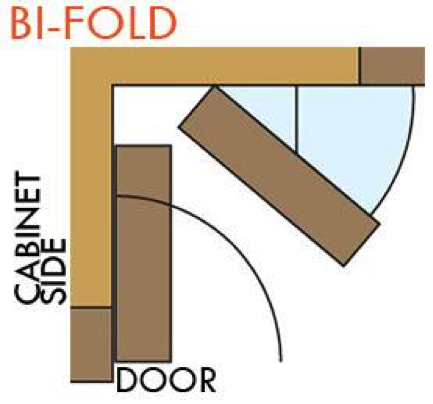All about hinges
Concealed hinges are used in every kitchen cupboard, but not many people are aware of the huge choice of type and size available, nor of their subsequent variety of uses. Before replacing a kitchen cupboard hinge, you must establish which is the right one for you.
Looking to replace a hinge? Head to our Hinge Helpdesk to find your best option.
Top 5 Types of Hinge in the Kitchen Cupboard
1. Full Overlay Concealed Hinge
This hinge type is the one most commonly used by kitchen manufacturers, due to its ability to completely hide the cabinet that the door is attached to. The Fully Overlay Concealed Hinge will have a straight arm as you look at it, whilst it allows the cupboard door edge to be completely in line with the edge of the cabinet. It is fully adjustable using just 3 little screws, which will adjust all of the angles and allow for the door frame to be totally concealed.

2. Half Overlay Concealed Hinge
Very similar to the Full Overlay, the Half Overlay allows for a door to be mounted on either side of a central carcass panel. Unlike the Full Overlay, this hinge has a bend in the arm; allowing the cupboard door edge to cover half the side panel, with the other half exposed. This hinge is also often used in wardrobes as well as kitchens.

3. Inset Concealed Hinge
A visually very different hinge to the Full Overlay and Half Overlay, with a large crank in the arm that allows the cupboard door to be inset or set inside. The cabinet frame shows the outer edge of the cupboard fully. The Inset Concealed Hinge is normally found on traditional solid wood furniture, as they nicely expose the wooden frame around the cupboard door. These hinges are also used with glass doors like kitchen display cabinets.

4. Blind Corner Hinge
The Blind Corner Hinge is used when there’s no 90° cabinet end panel to fix to but only an inline fascia. A minimum distance of 70mm is required from the inside edge of this fascia to fix the mounting plate and hinge to.

5. Bi-Fold Corner Hinge
This hinge style is used for double-door corner cabinets where the first door is attached to the cabinet side panel with a 170° hinge and the second door is attached to the first with a Bi-Fold hinge. It’s the ideal solution for kitchen corner cabinets that have been fitted with Carousels.

